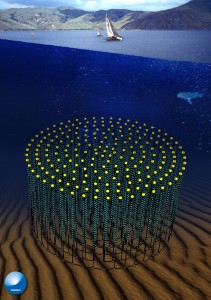By Alasdair Wilkins io9.com
Plans are afoot to build a gigantic, state-of-the-art neutrino detector beneath the Mediterranean Sea. This particle-hunting behemoth would be taller than the Burj Khalifa and the second biggest structure ever built, second only to the Great Wall of China.
 Concept art from Monster Hunter 3.
Concept art from Monster Hunter 3.
The structure is the work of a consortium of forty institutes and universities scattered across ten European countries. Given the catchy name of KM3NeT, the detector would measure several cubic kilometers in volume, all so that we have the best chance yet to spot these weakly interacting “ghost” particles. Because neutrinos don’t interact with other particles, we can use them to figure out the conditions of extremely distant part of the universe.
Studying astrophysical neutrinos should give us crucial new insight into exotic phenomena like gamma ray bursts, quasars, and supermassive black holes. In case you’re wondering, the extraterrestrial neutrinos we’re searching for here aren’t directly related to the possibly faster-than-light neutrinos, which were created as part of the OPERA experiment.
But it’s also because neutrinos are so fiendishly hard to spot that we have to build a gigantic, underwater detector – and that doesn’t even cover how ridiculously difficult it is to observe them in the first place. Far away across the universe, extremely powerful cosmic forces can rip apart subatomic particles, in the process creating super-energetic neutrinos. These fly off in all directions, and at least some of them end up headed towards Earth. When it reaches Earth eons later, it can hit a charged particle that, in turn, spits out a muon, which is a much more massive cousin of the electron.
The formation of the muon releases a flash of blue light known as Cherenkov radiation, and that is what the KM3NeT detector would be built to observe. It’s an insanely circuitous process that relies on plenty of luck, and in all our searching we’ve still only confirmed two extraterrestrial neutrino sources in the entire universe: our own Sun and supernova SN1987A.
When built, KM3Net will feature towers at least 2,600 feet tall, and the current designs call for them to exceed the height of Dubai’s 2,723-foot Burj Khalifa, currently the tallest building in the world. Of course, this wouldn’t simply be an underwater skyscraper – its vast network of towers would add up to three cubic kilometers, three times bigger than the current biggest detector, IceCube, and second only to the Great Wall of China in terms of largest human structures. All the towers would be fitted with arrays of spherical photomultiplier tubes, which are optical sensors that can spot the Cherenkov radiation in any direction. More info












